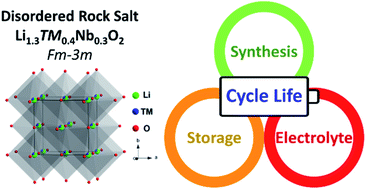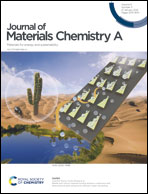Experimental considerations to study Li-excess disordered rock salt cathode materials†
Abstract
Cation-disordered rock salt materials have attracted much interest as high energy density cathode materials due to their anionic electrochemical activity, providing them extra capacity, along with their lower cost. They are, however, still the subject of numerous studies as they suffer from poor cyclability and relatively slow kinetics compared to traditional intercalation materials. In this work, several important experimental considerations, that must be taken into account when studying Li-excess cation disordered rock salt cathode materials, are introduced. First, the key synthesis parameters were identified to enable a lower-temperature, morphology-controlled synthesis of the Li3NbO4-based disordered rock salt cathodes Li1.3TM0.4Nb0.3O2 (TM = Fe, Mn), using nano-sized precursors. After evaluating the influence of the morphology on the cyclability of the electrode, two key challenges that hinder the practical implementation of these systems are revealed – ambient air-induced surface contamination and electrolyte compatibility. Thermal gravimetric analysis and X-ray diffraction on the nano-sized cathodes confirmed that prolonged air exposure generates a large amount of surface species, responsible for the large decrease in the first discharge capacity. Moreover, the influence of the electrolyte on the evolution of the cathode–electrolyte interphase was investigated using X-ray photoelectron spectroscopy. The results show that cation-disordered rock salt cathodes go through significant Li-salt degradation and develop thick cathode–electrolyte interphase with the electrolytes compatible with Li-excess layered cathode materials Li[Li0.144Ni0.136Co0.136Mn0.544]O2, highlighting the importance of evaluating and finding compatible battery chemistries.



 Please wait while we load your content...
Please wait while we load your content...
